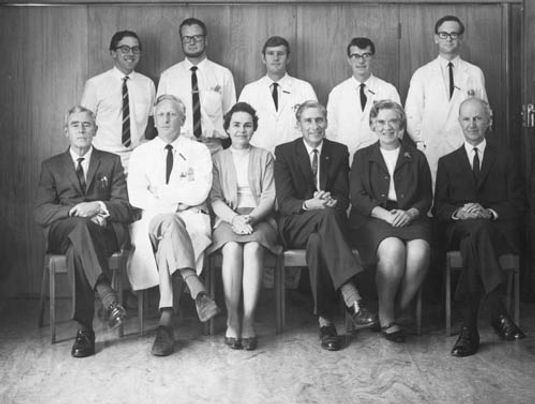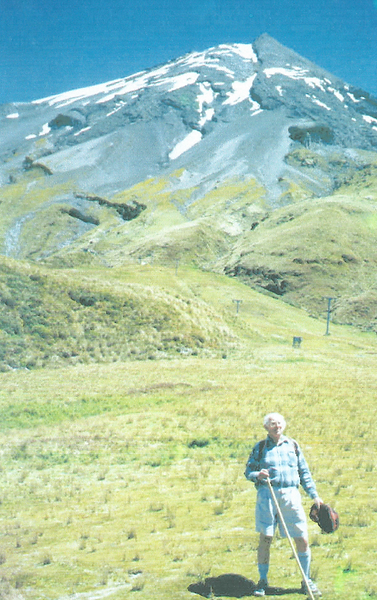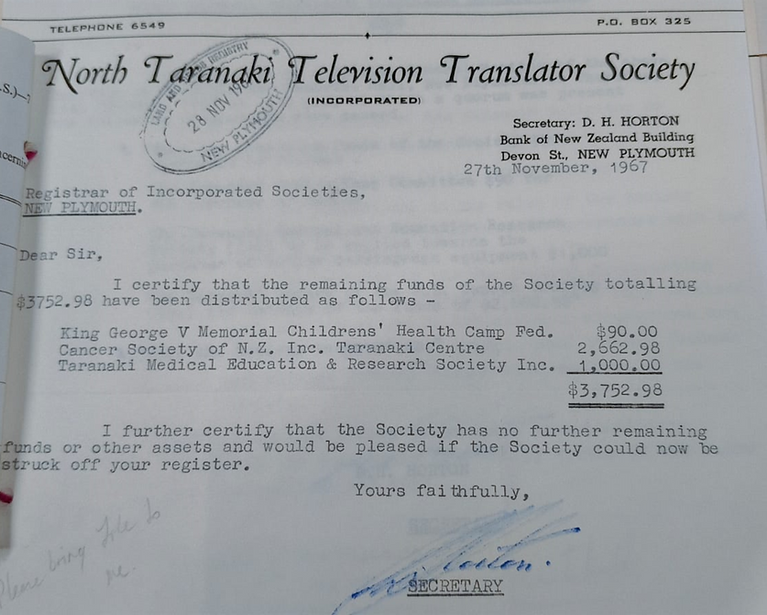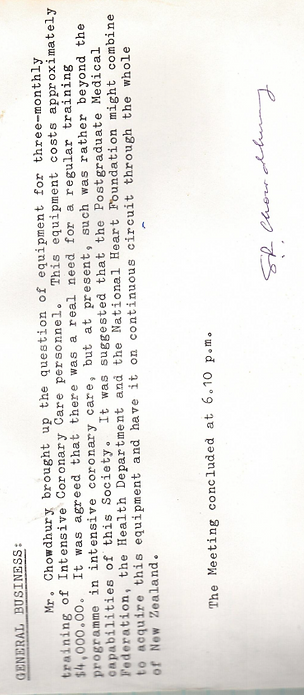
Founding Members
Meet the visionary doctors and community leaders who came together to create what is now the Taranaki Medical Foundation.
Their dedication to education, research, and regional care continues to inspire everything we do.
These are their stories that laid the foundations.
Dr Edmund Peter Allen
(1911–1991)
First President (1966–1968)
Honorary Life Member (January 1991)
MB ChB (Otago), MRCP (Edin), DMR (London), FRCRA, CBE, MBE

Image courtesy of Puke Ariki Museum Collection: https://collection.pukeariki.com/objects/177001/sydney-and-edmund-allen
📸 A young Peter Allen with his father, Dr. Sydney Chalmers Allen, c. 1911 – a legacy of care passed down through generations.
Radiologist
Civic Leader
Quiet Force Behind a Lasting Legacy
Born in Dunedin in 1911 into a family steeped in public service and medicine, Dr. Edmund Peter Allen carried forward a powerful legacy of care and civic leadership.
His heritage included connections to Sir Frederic Truby King, New Plymouth-born founder of the Plunket Society and pioneering advocate for maternal and child health, and to Dr. George Hanbury Farrady St George, one of Taranaki’s earliest surgeons, who arrived in 1842 and practiced in the region for over 50 years.
Dr. Allen’s father, Dr. Sydney Chalmers Allen (1877–1960), was a prominent medical practitioner in New Plymouth and a decorated officer in the New Zealand Medical Corps during World War I. His service to the Brooklands community in New Plymouth set a powerful example of local engagement and integrity.
Peter Allen was educated at King’s College, Auckland, and New Plymouth Boys’ High School, where he was Dux and a National Scholarship recipient. After graduating from Otago Medical School in 1935, he trained in radiology in London and at the Mayo Clinic in the U.S., eventually returning to New Plymouth in 1940 to become the region’s first full-time radiologist. He served at Taranaki Hospital for nearly four decades, pioneering diagnostic and therapeutic radiology, and introducing New Zealand’s first mobile chest X-ray unit.
In 1966, Dr. Allen became the first President of the Taranaki Medical Foundation, guiding its early development and shaping its mission to support local medical research and education. In 1970, TMF awarded him a grant to support his pioneering projects in radiotherapy and diagnostic pelvimetry.
Dr. Allen was also a lifelong contributor to civic life. He served as Deputy Mayor of New Plymouth (1968–1973) and chaired the Town Planning Committee for nearly 20 years. He was instrumental in establishing the Govett-Brewster Art Gallery, helped preserve the historic clock tower, and was a patron of the Taranaki Cricket Association, Friends of the Hospital, and numerous community arts and heritage groups.
Known for his quirky wit and firm standards, Dr. Allen never used a calculator—his fountain pen and slide rule were his trusted tools. He published numerous papers, received the Röntgen Award for best contribution to the British Journal of Radiology, and served as President of the Royal Australasian College of Radiologists.
In addition to his hospital and teaching roles, he helped establish Fulford Radiology at 56 Fulford Street, New Plymouth—a practice that continues to operate today. Together with his brother Dr. Chalmers Allen (FRACR) and colleagues Dr. Rhys Harding (BSc, FRACR), Dr. Raj Fernando (MRCP, FRCP) and Dr. Mark McCollough (FRCR), the group founded the practice to provide high-quality diagnostic radiology services to the Taranaki community. Fulford Radiology became an enduring part of the region’s healthcare infrastructure, a testament to their shared vision of accessible and advanced imaging services.
Awarded an MBE in 1977 and a CBE in 1990, Dr. Allen left behind a legacy that continues to influence medicine, art, and civic life in Taranaki. His signature appears on the original TMF minutes—a quiet gem of local history, and a powerful symbol of his leadership.
Selected Publications
Dr. Allen was a prolific contributor to the field of diagnostic and therapeutic radiology. His work appeared in internationally recognised journals such as the British Journal of Radiology, New Zealand Medical Journal, BMJ, and Australian Radiology.
He was awarded the Röntgen Prize for best contribution to the British Journal of Radiology, and his research helped advance techniques in pelvimetry, soft tissue radiography, and radiotherapy dosing.
Notable examples include:
-
Radiological Pelvimetry series – British Journal of Radiology, 1944–1949 (Sample article)
-
A Modified Barium Enema Technique – Australasian Radiology, 1966 (Read abstract)
-
A Trial of Radiation Dose Prescription Based on Dose-Cell Survival Formula – Australasian Radiology, 1984 (Related research)
Key list of publications from 1940 to 1984:
Miss Jean Mary Sandel
(1916–1974)
First Vice -President (1966–1968)
Second President (1968-1969)
Executive Committee Member (1972-1974)
MB ChB (Otago), FRCS (Eng), FRACS

Image credit: New Zealand Ministry for Culture and Heritage, via Te Ara – The Encyclopedia of New Zealand.
Source
📸 Medical staff including Jean Sandel
Dr Jean Sandel (front row, third from left) pictured with colleagues at New Plymouth Hospital, c.1950s.
Trailblazing Surgeon
Champion of Education
Enduring Legacy
Miss Jean Sandel was one of New Zealand’s most distinguished surgeons and a founding force behind the Taranaki Medical Foundation.
Born in 1916 and raised in Taumarunui, she showed academic brilliance from an early age. As a boarding student at New Plymouth Girls’ High School, she was Dux for two consecutive years and Head Girl in 1933. She entered Otago Medical School on a Senior National Scholarship and graduated MB ChB in 1940, having won multiple academic prizes, including the Travelling Scholarship.
She pursued surgery at a time when few women did—not as an act of defiance, but from a quiet, determined belief in her vocation. After gaining significant surgical experience during the war years, she travelled to England in 1946 and in 1947 became the first New Zealand woman to be awarded the Fellowship of the Royal College of Surgeons of England (FRCS). She returned home in 1950 to begin what would become a lifetime of service at New Plymouth Hospital, where she later became Director of Surgery and a respected teacher and mentor.
Sandel’s clinical work was known for its precision, endurance, and deep compassion. Her surgical lists were famously full, her standards exacting, and her concern for patient welfare absolute. She was a stern but effective teacher, held in high regard by staff and trainees alike. Even in her final year, as her health declined, she continued to operate and lead with extraordinary stamina.
She played a formative role in the founding of the Taranaki Medical Education and Research Society (now TMF) in 1966. She served first as Vice President, then as President from 1968–1969, and remained active as an executive member representing the New Plymouth Staff Association until her death.
A strong advocate for regional education and access to medical innovation, she led and supported several initiatives, including:
-
The screening of “Prescription for Life,” a public health education film broadcast across Taranaki with help from the Mount Egmont Translator tower
-
A 1973 regional neurology and neurosurgery weekend course, offered free to all doctors in Taranaki and Whanganui
-
A push to fund local research, despite challenges in participation from rural practitioners
Outside the hospital, Jean Sandel had a vibrant and wide-reaching life. A keen sports fan, she held a lifetime seat at Eden Park and travelled often to Auckland and Wellington to attend major rugby and cricket tests. She was an active member of the New Plymouth Soroptimist Club and a passionate bridge player. Her historic home, "Brackenhurst", on Pendarves Street—then known as York Terrace—was renowned for its beautifully tended garden. She often gifted flowers to friends, a quiet reflection of her deep love for nature and her enduring instinct to care, not only in surgery, but in all corners of life.
Her faith was central to her life. A committed Presbyterian, she quietly supported many social service initiatives. In her will, she left significant bequests to the Presbyterian Social Services Association, with instructions to fund a geriatric hospital or, alternatively, support the work of Chalmers Home in New Plymouth. Despite the demands of surgery, she cared for her mother during a long terminal illness without ever revealing her own cancer diagnosis.
She also left funds to Taranaki Base Hospital, specifically earmarked to create recreational amenities for medical staff—including a squash court—reflecting her deep and lasting care for the wellbeing of those she represented. Even in preparing her will, she remained a steadfast advocate for her colleagues’ health and balance.
Jean Sandel passed away in November 1974, aged just 57. Her funeral filled St. Andrew’s Church, a testament to the community’s deep love and respect. Though she never sought attention for her achievements, her legacy continues—etched into Taranaki’s medical history, and in the lives of the many she healed, taught, and quietly supported.
In 1975, Dr Peter Allen, Mr Robson, and Rev. W.T. Woods joined medical staff in dedicating a memorial garden outside the New Plymouth Hospital chapel in her honour. It remains a place of peace and reflection, a living tribute to a life of service.
Her name lives on in the Jean Sandel Retirement Village, in the church window dedicated to her, in TMF’s founding records, and in every young woman who now sees surgery not as an impossibility—but as a path she helped clear.
An official biography of Jean Sandel was authored by fellow TMF founder Dr. Victor Hadlow and published in the Dictionary of New Zealand Biography.
Read it on Te Ara – The Encyclopedia of New Zealand
“Perhaps Jean Sandel’s greatest achievement was that a stranger, meeting her socially and captivated by her quiet charm, would never have guessed they were speaking with one of New Zealand’s most distinguished professional women.”
— JHF, 1974 tribute in the Taranaki Herald
“As a woman surgeon, Jean Mary Sandel was a rarity.”
— Margaret D. Maxwell,
Women Doctors in New Zealand: An Historical Perspective, 1921–1986
Dr Alan Colin Hayton
(1919–2012)
First Honorary Secretary (1966–1974+)
Honorary Life Member (1991)
MB ChB (Otago), MRACP, MRCP(London), FRCP(London)

Physician
Passionate Historian
Truth-Seeker
Dr. Alan Colin Hayton was a distinguished New Zealand physician whose dedication to medicine and community service left a lasting impact on Taranaki. Born in Hāwera on 24 July 1919, he was the third son and fifth child of Ernest Colin and Lilian May Hayton. He attended Central School and New Plymouth Boys' High School, where he excelled academically and athletically, earning a place on the First XV rugby team and securing the Taranaki Scholarship in 1936.
In 1937, Hayton commenced medical studies at the University of Otago, graduating in 1942. During his university years, he joined the Otago University Medical Company, balancing his studies with military training. Following his fifth year, he was commissioned and served as an acting house surgeon at Wellington Hospital. By mid-1943, amidst World War II, Hayton was released from hospital duties to serve in various military camps across New Zealand, conducting health checks for servicemen on furlough. In early 1945, he was posted overseas as a captain with the 1st Battalion of the Fiji Infantry Regiment, a unit comprising Fijian privates with New Zealand and Fijian officers and NCOs. He was discharged from military service in 1947 with the rank of major.
While in Fiji, Dr. Hayton immersed himself in the challenges of tropical medicine. He managed and monitored conditions such as trachoma and filariasis, collecting blood samples from officers and examining them nightly under a microscope at a civilian hospital in Suva. His vigilance reassured both his commanding officers and fellow medical personnel amid fears of disease outbreaks, particularly among the New Zealand contingent.
He was also tasked with ensuring compliance with antimalarial prophylaxis—most notably the daily administration of atebrin, a drug vital to preventing debilitating malaria. When reports showed that only a small percentage of troops were taking their doses, Dr. Hayton was caught in the middle of military tension and medical responsibility, reinforcing his role not only as a clinician but as a health leader under pressure. These wartime experiences shaped his lifelong interest in rigorous observation, public health, and the human side of medical service.
In his later years, that same medical commitment carried into a love for travel and adventure. He supported mountaineering expeditions by advising on and preparing medical kits for climbers—bringing his diagnostic precision and thoughtful care from Taranaki’s wards to some of the world’s most remote places.
Returning to New Plymouth in 1951, Dr. Hayton entered general practice, eventually transitioning into specialist practice in internal medicine. He was a visiting physician at New Plymouth Public Hospital and Taranaki Base Hospital, dedicating his career to improving healthcare in the region. He proudly described himself as a "general jobbing physician," a role some considered a dying breed. This sentiment is encapsulated in his own words: "Some would say a dying breed, some say yes alas, and others say and just as well." This quote is taken from his personal profile and publications archived at Puke Ariki
In 1966, Dr. Hayton played a pivotal role in the formation of the Taranaki Medical Foundation. As secretary of the Postgraduate Committee, he helped instigate the Foundation’s creation, advocating for the formal establishment of a body to support regional medical education and research. At the inaugural meeting in July 1966, he was elected as the first Honorary Secretary and was authorized to incur expenses for circularizing doctors across the region and to arrange press and radio publicity.
Dr. Hayton wrote the foundational letter to Taranaki doctors outlining the purpose and promise of the new society:
"A financially strong organisation will benefit us all... It will help maintain your own standards of medical competency and give you the satisfaction of supporting medical education and research."
Through his clear communication and advocacy, early support for the Foundation began to grow—including donations from individuals and community organisations.
Dr. Hayton's contributions to medical research were notable. In collaboration with his colleague, Miss Jean Sandel, he co-authored a case report on "Retroperitoneal fibrosis following methysergide use" published in the New Zealand Medical Journal in 1966. Methysergide was a widely used drug for treating migraines and related vascular headache syndromes at the time. Later, in a solo publication in the New Zealand Medical Journal in March 1978, he detailed the adverse effects of the beta-blocker drug Practolol, which was found to cause peritonitis. His findings contributed to the worldwide withdrawal of Practolol from the market, marking a significant victory for patient safety.
Beyond his medical endeavors, Dr. Hayton had a profound interest in history, authoring several publications on medical history and local heritage. His meticulous research and dedication earned him recognition as a historian of New Plymouth. He was particularly noted for his investigative nature, often likened to a bloodhound for his ability to sniff out historical puzzles and piece together seemingly insignificant evidence to solve past mysteries. As a "Friend of Keats," he followed a clue from the 1930s and traced a copy of Fairfax's translation of Tasso's poems with handwritten inscriptions from Charles Cowden Clarke to the Allen family's forefathers—Thomas King, father of Sir Truby King and Newton King, who lived on the corner of Dawson and Vivian Streets. Another notable discovery was a rare medical book, "An Inquiry into the Causes and Effects of the Variolae Vaccinae" by Edward Jenner, which was in the possession of Dr. Peter Wilson, considered New Plymouth's early Colonial surgeon. Dr. Hayton facilitated the return of this book with the help of Dr Wilson's great-granddaughter, Helen Warren, after almost 200 years, to the University of Virginia.
Dr. Hayton passed away in 2012 at the age of 93, leaving behind a legacy of thoughtful leadership and persistence that helped shape the Foundation’s earliest days. His passionate drive to ensure that the history of medicine was cherished and challenged continues to inspire future generations to question and seek the truth
Here are his notable research papers:
-
Hayton AC. Practolol peritonitis with autopsy findings. N Z Med J. 1978 Mar;87(607):177-179. PMID: 274658.
-
Sandel JM, Hayton AC, Law PW. Retroperitoneal fibrosis after methysergide. N Z Med J. 1967 May;66(417):310. PMID: 5230123.
-
Hayton AC. Precipitation of acute ergotism by triacetyloleandomycin. N Z Med J. 1969 Jan;69(440):42. PMID: 5304704.
-
Hayton AC. The unfortunate Dr MacShane of Nelson and New Plymouth. N Z Med J. 1978 Jan;87(603):20-23. PMID: 347341.
-
Hayton AC, Mullan HD. Dr McBean Stewart's stamp. N Z Med J. 1977 Jul;86(591):35. PMID: 271864.
-
Hayton AC. Evaluation of a diabetes education programme. Aust N Z J Med. 1982 Dec;12(6):657-658. PMID: 6962721.
💬 From the Desk of Dr. Alan Hayton (1991)Upon receiving Honorary Life Membership on Valentine's Day, 1991, Dr. Hayton wrote the following acceptance letter to the then Honorary Secretary Mr. W T C Gilkison...

🕊️ Remembering Dr. Hayton’s Service
Alongside his lifelong dedication to medicine and history, Dr. Hayton’s service in the New Zealand Army during WWII remains a significant chapter in his story. He served with distinction as a medical officer in New Zealand and the Pacific, and was discharged with the rank of Major.
📜 His military record is preserved by the Auckland War Memorial Museum and can be viewed here:
Dr Alan Colin Hayton – Online Cenotaph, Auckland Museum
He served his country with the same thoughtful commitment that defined his life in medicine—quietly, steadily, and with enduring purpose.
Dr. John Joseph Valentine
(1925–2015)
First Treasurer (1968–1973)

📸 High Above Taranaki – Translator Tower - Hen and Chicken Site
Perched at approximately 1500m on the north-eastern slopes of Mt Taranaki, this tower was home to the region’s first television translator. Initially relaying Wellington’s WNTV1 broadcast, it was adapted in 1966 to receive the Auckland signal via Channel 1 (Te Aroha). This technical upgrade significantly improved the reliability and clarity of television reception across Taranaki — bringing national stories to local screens from above the clouds. Image courtesy of Andrea Jupp
General Practitioner
Author
Advocate for Equity
Dr. John Joseph Valentine was a respected general practitioner in New Plymouth, known for his compassionate care and quiet advocacy for those often overlooked. He served as the first Treasurer of the Taranaki Medical Foundation, playing a pivotal role in establishing the Foundation’s early financial structure and accountability.
As Treasurer, Dr. Valentine helped build a transparent and inclusive funding framework. Early support came from community-minded donors—including the Wicksteed family (in memory of a loved one), Mrs. Olive Allen, and the North Taranaki Television Translator Society, whose generous $1,000 gift was earmarked for cardiac equipment.
Alongside these contributions, member subscription fees (set at £3) seeded a sustainable grant fund. In a 1966 letter to regional doctors, the founders emphasised the importance of “grants-in-aid for future courses and lectures… [to] help keep down course fees and bring top-flight doctors into the province.” From the outset, any doctor or organisation in Taranaki—member or not—could apply for support toward medical education or research. This ethos of openness and community support continues to define the Foundation’s values today.
The translator tower itself would later be used to broadcast Prescription for Life, a public health film championed by fellow founder Jean Sandel. In this way, the Foundation’s earliest donations became tools for both clinical advancement and community education.
Dr. Valentine practiced medicine for 36 years at his Carrington Street clinic, caring for many of New Plymouth’s lower-income and unemployed residents. Upon his retirement in 1999, he voiced concern about the hidden poverty affecting nearly one-third of the city’s population—people who, he said, “battled bravely and uncomplainingly,” often unnoticed by society.
In 2009, he published Hell-Bent for Life, a memoir reflecting on his personal and professional journey. Dr. Valentine passed away in 2015, at the age of 89, leaving behind a legacy of deep compassion, thoughtful leadership, and lifelong service to Taranaki’s people.
Winding Up with Purpose – 1967
Official correspondence marking the closure of the North Taranaki Television Translator Society. As part of their final disbursements, the Society donated $1,000 to the Taranaki Medical Education & Research Society (now the Taranaki Medical Foundation), supporting early investment in cardiac research equipment.
📸 Image courtesy of Puke Ariki Resource Library Archive
.png)
Mr. Salil Roy Chowdhury
(1928–2015)
Second Vice-President (1968–1969)
Third President (1969-1974)
BSc (Hons), MBBS (India), FRCS (England), FRACS (New Zealand)
Surgeon
Superintendent
Champion of Rural Healthcare
Born in New Delhi and educated in Calcutta and the UK, Mr. Salil Roy Chowdhury (widely known as “Roy”) brought global experience and a deeply human approach to his surgical and leadership roles in Taranaki. After completing his BSc (Hons) in Delhi and his MBBS in Calcutta in 1953, he earned his FRCS (England) in 1961 and later his FRACS in New Zealand.
He arrived in Taranaki in 1966 to serve as a full-time surgeon at Hāwera Hospital and was soon appointed Surgeon Superintendent in 1969. Known for his compassion, quiet leadership, and clinical skill, Roy championed the importance of maintaining surgical services in regional hospitals and helped oversee the development of Hāwera’s intensive care unit.
Within the Taranaki Medical Foundation, Mr. Chowdhury was elected Vice President in 1968 when Miss Jean Sandel became President. On 7 August 1969, she passed the presidential mantle to him, and he served in this role until 1974. His presidency was marked by both thoughtful vision and detailed action. On 17 July 1969, he raised the critical need for specialist equipment to support a three-monthly training programme in intensive coronary care—at a time when the estimated cost of such a programme ($40,000) was beyond the Foundation’s means. Rather than let the matter drop, he proposed a coordinated national solution involving the Postgraduate Medical Federation, the Health Department, and the National Heart Foundation to jointly fund mobile equipment that could rotate through hospitals across New Zealand.
In June 1970, he wrote to TMF advocating for continued in-service surgical training to ensure Taranaki hospitals maintained their approval by the Royal Colleges. His commitment to professional standards, regional training, and collaborative solutions became hallmarks of his leadership. He was re-elected President annually from 1970 through 1974, reflecting the strong confidence his colleagues placed in him.
Beyond medicine, Mr. Chowdhury was a dedicated Rotarian, first becoming involved with Rotary while living in Hāwera—a commitment he continued after moving south. In Blenheim, he joined the Blenheim Rotary Club and was President in 1984-85 and was awarded the Paul Harris Fellowship (April 1995) for outstanding service to the Club and Community. He was also a tireless advocate for public health equity. After relocating to the South Island in 1981 to continue his surgical career at Wairau Hospital, he became President of the Marlborough branch of the Cancer Society (1986–88). Concerned by the region’s high rate of skin cancer, he initiated and organised New Zealand’s first free skin cancer screening clinic in Blenheim in 1988. The clinic brought together specialists including plastic surgeon Gary Duncan (Wellington) and dermatologist Peter Sears, providing vital early detection services to the local community. This pioneering effort reflected Roy’s lifelong dedication to preventive healthcare and community wellbeing.
He also found joy in gardening, trout fishing, woodworking, and cricket—often travelling from Hāwera to Auckland or Wellington for test matches. Admired for his humility, calm presence, and quiet humour, he was as respected by hospital staff as he was by his patients.
Mr. Chowdhury’s contributions to surgery, hospital development, and regional medical education live on through the institutions he served—and through the communities that continue to benefit from his work.
📖 Further Reading:
Dr. Chowdhury’s career and character have been honoured by professional colleges on both sides of the world:
🔹 Royal Australasian College of Surgeons (FRACS, 1969)
Obituary – RACS
🔹 Royal College of Surgeons of England (FRCS, 1961)
Obituary – RCS England

